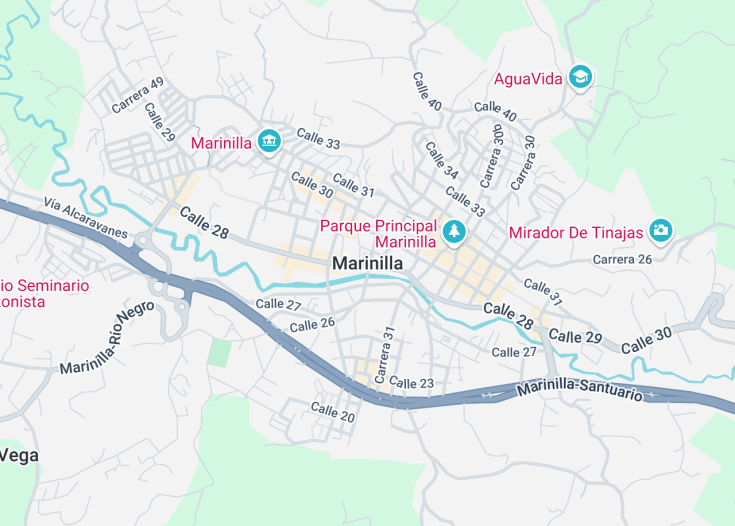Marinilla, Colombia is a captivating town known for its rich cultural heritage and breathtaking landscapes. Nestled near the famous city of Medellín, Marinilla offers a unique blend of historical significance and modernity, making it an ideal destination for both history enthusiasts and nature lovers.
The town boasts remarkable colonial architecture, vibrant festivals, and a warm, welcoming community. Its proximity to natural reserves and parks provides numerous opportunities for outdoor activities, ensuring a memorable experience for all visitors.
For the best cultural experience in Marinilla, plan your visit during the Festival of the Crosses in May, when the town bursts into life with music and color.
Enjoy a serene afternoon at Parque Los Salados, which offers stunning lake views and ample opportunities for picnicking and leisurely walks.
Marinilla: A Hidden Gem in Colombia
| Country | Colombia |
| Time in Marinilla | GMT-5 |
| Language spoken | Spanish |
| Population | 51,033 (Data from DANE) |
| Currency | Colombian Peso (COP $) |
| Airports |
|
Marinilla, a picturesque town in Colombia, is rich in history and culture. Nestled in the Eastern Antioquia region, it is just a stone throw away from the major city of Medellín. Known for its beautiful colonial architecture and a vibrant cultural scene, Marinilla’s charming streets are lined with colorful houses and a friendly atmosphere that welcomes tourists. It is also a gateway to various natural attractions in the area.
Where is Marinilla?
Marinilla is situated in the department of Antioquia, approximately 30 miles east of Medellín in Colombia.
Distances:
| Route | Distance by car | Time by car |
|---|---|---|
| Medellín to Marinilla | 30 mi | 1 hr |
| Rionegro to Marinilla | 8 mi | 15 min |
What is Marinilla famous for?
Marinilla is notably recognized for its artistic heritage, particularly in music and craftsmanship. The town frequently hosts cultural festivals that attract performers and tourists from across Colombia, showcasing its commitment to preserving and celebrating its rich cultural traditions.
History
Pre-Colonial Period
Before the arrival of Spanish colonizers, the area now known as Marinilla was inhabited by indigenous tribes, primarily the Tahamíes, who were part of the larger Carib linguistic group. These indigenous people were primarily engaged in agriculture, hunting, and goldsmithing, living harmoniously within the lush landscapes of the region.
1537-1810: Colonial Era
In 1541, Spanish explorer Jorge Robledo was among the first Europeans to encounter the region as part of his explorations through the northern part of what is now Colombia. However, Marinilla itself was founded on December 26, 1787, by Francisco Molina. During the colonial period, the town was known as “Valle de San Nicolás” and was an important center for trade between the highland and lowland regions. The Spanish influenced local architecture, social structures, and the economy, establishing cattle ranching and agriculture as economic staples.
1810-1950: Growth and Development
Following Colombia’s independence from Spanish rule in the early 19th century, Marinilla played a significant role in the country’s economic and cultural development. The town became known for its educational institutions and as a regional hub for politics and commerce. The completion of the Ferrocarril de Antioquia in the early 20th century further integrated Marinilla with Colombia’s larger economic networks, facilitating the export of agricultural products and the import of goods.
1950-Present: Modernization
In the latter half of the 20th century, Marinilla began to modernize rapidly, with improvements in infrastructure such as roads, telecommunications, and public services. Today, Marinilla is recognized for its preserved colonial architecture, vibrant cultural scene, and as a key player in Antioquia’s economic landscape. The town continues to honor its rich history while also embracing modernity, making it a unique blend of the old and new.
Visit Marinilla
What to see and do in Marinilla, Colombia.
Marinilla offers a charming blend of historical and cultural attractions. Visitors can explore iconic sites such as the Basilica of Our Lady of the Assumption, a stunning example of colonial architecture.
The nearby reservoir, Piedras Blancas, is perfect for ecotourism activities like hiking and bird watching. The town is also home to vibrant markets where local crafts and culinary delights can be enjoyed. For those interested in history, the Marinilla Historical Museum provides insights into the local heritage.
- Basilica of Our Lady of the Assumption
- Piedras Blancas Reservoir
- Local craft markets
- Marinilla Historical Museum
Key Events in Marinilla
Marinilla hosts several cultural events throughout the year that celebrate its rich customs and community spirit. Notable events include the Marinilla Music Festival, usually held in July, which features a wide range of traditional and contemporary music performances.
In December, the town comes alive with the Festival of Lights, coinciding with the Christmas season. These events provide a great opportunity for visitors to experience local traditions and festivities.
Best time to visit Marinilla
The best time to visit Marinilla is during the dry seasons, from December to March and July to August. This period offers the most pleasant weather for exploring the town’s outdoor attractions and participating in local events.
Is Marinilla worth visiting?
Indeed, Marinilla is worth visiting for anyone interested in experiencing a unique blend of history, culture, and natural beauty. The town offers an impressive array of attractions and activities that cater to different interests, from historical exploration in its museums and churches to engaging in outdoor adventures at nearby natural reserves.
Additionally, Marinilla’s vibrant cultural scene and warm, welcoming community enhance its appeal as a travel destination, making it a memorable part of any Colombian itinerary.









